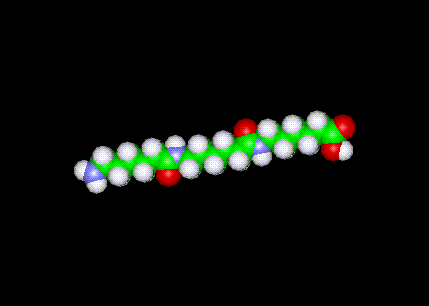Nylon Molecule (Nylon-6)

For 3-D Structure of Nylon Molecular Structure using Jsmol
Nylon is a synthetic polymer, a plastic, invented on February 28, 1935 by Wallace Carothers at the E.I. du Pont de Nemours and Company of Wilmington, Delaware, USA. The material was announced in 1938 and the first nylon products; a nylon bristle toothbrush made with nylon yarn (went on sale on February 24, 1938) and more famously, women's stockings (went on sale on May 15, 1940). Nylon fibres are now used to make many synthetic fabrics, and solid nylon is used as an engineering material.
Chemically, nylon is a condensation polymer made of repeating units with amide linkages between them: hence it is frequently referred to as a polyamide. It was the first synthetic fibre to be made entirely from inorganic ingredients: coal, water and air. These are formed into two intermediate chemicals, most commonly hexamethylene diamine and adipic acid (a dicarboxylic acid), which are then mixed to polymerise. The most common variant is nylon 6,6, also called nylon 66, which refers to the fact that both the diamine and the diacid have 6 carbon backbones. The diacid and diamine units alternate in the polymer chain. Therefore, unlike natural polyamides like proteins, the direction of the amide bond reverses at each bond.
There is no evidence for the popular belief that "nylon" is a contraction of "NY" (for "New York") and "Lon" for "London", the two cities where the material was first manufactured. In 1940 John W. Eckelberry of Du Pont stated that the letters "nyl" were arbitrary and the "on" was copied from the names of other fibres such as cotton and rayon. A later publication by Du Pont (Context, vol. 7, no. 2, 1978) explained that the name was originally intended to be "No-Run" ("run" in this context meaning "unravel"), but was then modified to avoid making such an unjustified claim and to make it sound better. The story goes that Carothers changed one letter at a time until Du Pont's management were satisfied.
Even though the word nylon was coined, it was never trademarked.
During World War II, nylon replaced Asian silk in parachutes. It was also used to make tires, tents, ropes, ponchos, and other military supplies. It was even used in the production of a high-grade paper for US currency. At the outset of the War, cotton accounted for more than 80 percent of all fibres used, and manufactured and wool fibres accounted for the remaining 20 percent. By August, 1945, manufactured fibres had risen to 25 percent, and cotton had dropped to 75 percent.
Some conspiracy theorists surmise that cannabis was made illegal because the fibres from the hemp plant, used for fabrics and ropes, were in strong competition with nylon. However, nylon fiber is more than twice as strong as hemp fiber and weighs 25% less. While hemp was originally used in climbing rope, it is now virtually unused in modern climbing, including countries where cannabis is legal.